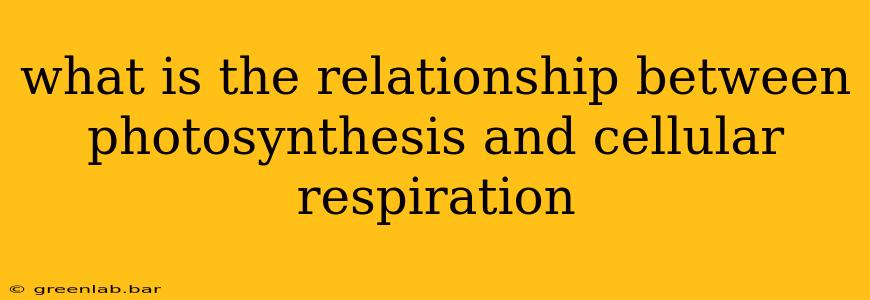Photosynthesis and cellular respiration are two fundamental processes in biology, often described as opposites. While seemingly distinct, they are intricately linked, forming a cyclical relationship that sustains almost all life on Earth. Understanding their connection reveals a beautiful example of biological synergy.
Photosynthesis: Capturing Solar Energy
Photosynthesis is the process by which green plants and some other organisms use sunlight to synthesize foods with the help of chlorophyll. This remarkable process converts light energy into chemical energy in the form of glucose (a sugar). The overall reaction can be summarized as:
6CO₂ + 6H₂O + Light Energy → C₆H₁₂O₆ + 6O₂
This means six molecules of carbon dioxide and six molecules of water, in the presence of light, are transformed into one molecule of glucose and six molecules of oxygen. The glucose serves as the plant's primary energy source and building block for other organic molecules. The oxygen, a byproduct, is released into the atmosphere, crucial for the respiration of many organisms.
Key Components of Photosynthesis:
- Chlorophyll: The green pigment that absorbs light energy.
- Chloroplasts: The organelles within plant cells where photosynthesis occurs.
- Stomata: Tiny pores on leaves that allow for gas exchange (CO₂ intake and O₂ release).
Cellular Respiration: Harvesting Chemical Energy
Cellular respiration is the process by which cells break down glucose and other organic molecules to release energy stored within their chemical bonds. This energy is then used to power various cellular activities, such as growth, repair, and movement. The overall reaction is essentially the reverse of photosynthesis:
C₆H₁₂O₆ + 6O₂ → 6CO₂ + 6H₂O + ATP
Glucose reacts with oxygen to produce carbon dioxide, water, and most importantly, ATP (adenosine triphosphate). ATP is the cell's primary energy currency, providing the energy needed for numerous cellular processes.
Key Stages of Cellular Respiration:
- Glycolysis: The initial breakdown of glucose in the cytoplasm.
- Krebs Cycle (Citric Acid Cycle): Further breakdown of glucose derivatives in the mitochondria.
- Electron Transport Chain: A series of redox reactions that generate the majority of ATP.
The Symbiotic Cycle: A Perfect Balance
The relationship between photosynthesis and cellular respiration is cyclical and interdependent. Photosynthesis produces the glucose and oxygen that are used in cellular respiration. Cellular respiration, in turn, produces the carbon dioxide and water that are used in photosynthesis. This continuous exchange sustains the flow of energy within ecosystems.
Here's a simplified representation:
- Plants use sunlight, water, and carbon dioxide to produce glucose and oxygen through photosynthesis.
- Animals and plants consume glucose, using oxygen to break it down during cellular respiration, releasing energy (ATP) and producing carbon dioxide and water.
- The carbon dioxide and water are then used by plants in photosynthesis, restarting the cycle.
Ecological Significance: The Foundation of Life
The interplay between photosynthesis and cellular respiration is crucial for maintaining the balance of life on Earth. Photosynthesis is responsible for producing the oxygen in our atmosphere, while cellular respiration drives the energy flow within all living organisms. The disruption of either process would have devastating consequences for the entire ecosystem.
This intricate relationship highlights the elegance and interconnectedness of biological processes. It's a testament to the efficiency and sustainability of nature's design. Further research into these processes continues to reveal more details about their complexity and significance in maintaining life as we know it.

